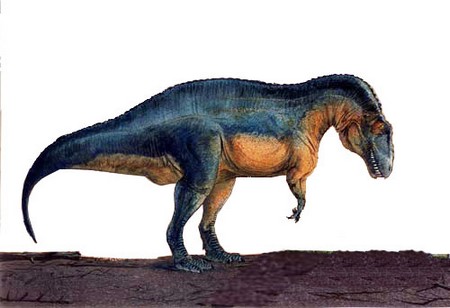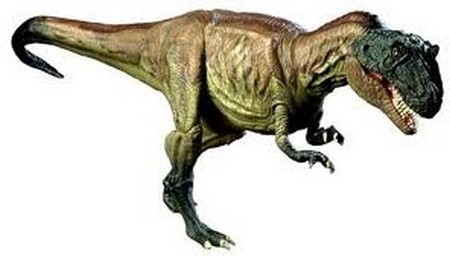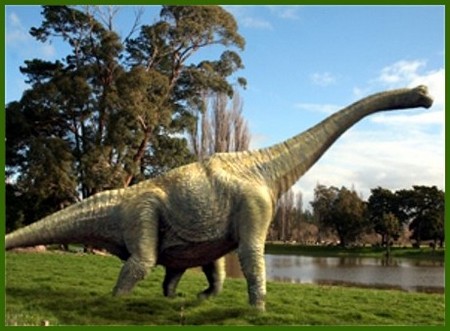Geologically, the history of earth is divided into three major eras mentioned in descending order to oldest, i.e. Cenozoic Era the period beginning 65 million years ago till today, then come the Mesozoic Era that was from 248 to 65 million years ago and the oldest era is the Paleozoic Era that was from 542 to 248 million years ago. These eras are divided into different periods such as Cenozoic Era is divided into Quaternary, Neogene, Paleogenel; Mesozoic Era is divided into Cretaceous, Triassic Jurassic; Paleozoic Era is divided into Permian, Carboniferous, Devonian, Silurian, Ordovician, and Cambrian. Dinosaurs were the animal group that thought to be come in existence in Triassic period of Mesozoic era.
It is assumed that the dinosaurs were evolved 230 million years ago from primitive reptiles known as archosaurs, the ruling lizards of the Mesozoic era. The lizards were smaller than the dinosaurs and had different features. There is another concept which says that therpsids (a hybrid of mammals and reptiles) could also have been the ancestors of dinosaurs. The early dinosaurs were fleet-footed bipeds that lived on meat and plant. The fossil remains found on Madagascar islands shows that these creatures were 10 to 15 feet in height. Gradually, these dinosaurs evolved into quadrupeds and the therapsids declined quickly with the evolution of dinosaurs. The dinosaurs grew in size during their evolution periods. However, at the end of Mesozoic era, 65 million years ago, these creatures, i.e. dinosaurs and pterosaurs disappeared abruptly. This end of dinosaurs’ era is known as Cenozoic era.
As far as dinosaurs are concerned, the most lively and distinct images of these majestic creatures are created by Steven Spielberg in his famous movie ‘Jurassic Park. This movie in fact was the visual representation of the novel ‘The Lost World’ by Michael Crichton. This movie surprised a lot of people who were not aware of the fact that this majestic creature was once roamed freely on the planet earth. Dinosaurs were of different types that is some were herbivores, others omnivores and some even carnivores. Let us have a brief look on some of the types of dinosaurs.
Acrocanthosaurus
It was a carnivorous bipedal dinosaur (two footed) lived about 125 to 100 million years ago in the present North America, during mid-Cretaceous period. The fossil was discovered in Oklahoma, Texas. It is assumed that this creature grew up to the length of 40 feet and weighed about 2.4 tons. The characteristic feature of this creature was a large neural spine on the vertebrae, stretching from the neck to the upper tail. It worked to act as a reservoir of fat and temperature regulator. Acrocanthosaurus had strongly built forelimbs which were stiff and short. The head of this creature was long and narrow and the tail was heavy and long that helped the dinosaur to balance the weight of the head and body.
Albertosaurus
This type of dinosaur was lived in the North American region during the lat-Cretaceous period, about 76 to 74 million years ago. The first specimen of this creature was found in the form of a partial skull near the Red Deer River in Alberta, Canada in1884. It was a carnivorous bipedal dinosaur having very small forelimbs, long hindlimbs with four toed foot. The expected weight of this creature was 3 tons with a height of 26 feet. It had a massive head with sharp teeth. Its name was given after an American geologist and paleontologist, Henry Fairfield Osborne.
Allosaurus
It was a type of huge dinosaur inhabited in North America in the late Jurassic and early Cretaceous period about 154 to 135 million years ago. Its fossil specimens were also discovered in Africa and Australia. The term ‘allosaurus’ is a combination of two Greek words, ‘allos’ means strange or different and ‘saurus’ means a large dinosaur.
Generally, these creatures were 30 feet in length with some exceptions of 39 feet. It was also bipedal with a large head, having sharp teeth and a short neck. It has large and powerful hindlimbs, while forelimbs were relatively smaller and three fingered. It also had a long heavy tail used to balance its weight. It is assumed that these dinosaurs hunt in groups and were not only hunt the larger herbivorous dinosaurs but also carnivorous dinosaurs.
Gigantosauros
These dinosaurs were the inhabitant of Argentina about 93 to 89 million years ago during the Cretaceous period. These creatures grew up to the length of 43 feet and weighed about 6.2 tons. Ruben Carolini discovered the first fossil specimen of this dinosaur in Southern Argentina in1993. These were considered to have a good sense of smell for they possessed a well developed olfactory region in the brain.
Tyrannosaurus Rex
A bipedal carnivorous, having a massive skull and long, heavy tail were lived in North America and Asia, almost 93 to 89 million years ago during the late Cretaceous period. It was assumed that it grew up to the length of 39 feet, but the largest fossil found is about 42 feet in length. They rose to the average height of 20 feet with an average estimated weight of 7 tons. It was thought to be the largest dinosaur before the discovery of Gigantosaurus.
These were thought to scavenger because they were not assumed to be a fast runner. They had strongly built, small forelimbs, the largest hindlimbs among all the theropod dinosaurs with two-clawed fingers. It had a skull wide at the rear end, but narrow at snout. They had a curved large teeth with the largest being 30 cm in length which was largest for any carnivorous dinosaur.
Spinosaurus
Also known as spine lizards lived on earth about 95 to 70 million years ago. Previously, it was assumed that they were 39 feet long and weighed about 7 tons. However, the recent studies reveal that it was a large animal that was 51 feet in length and weighed about 9 tons. The major feature of this dinosaur was 6 feet long, fin-shaped spine on its back used for temperature regulation. It had large skull of about 1.75 meter long, which is largest skull among all carnivorous.
Achelousaurus
This type of dinosaur is supposed to be the transition form between the ceratopsians (horned dinosaurs) and the hornless dinosaurs. It was inhabited in North America at almost 83 to 74 million years ago during the period of Cretaceous. These creatures were supposed to be 6 tons in weight and had a length of about 20 feet. It was in 1995 when the first fossil specimen of this creature was discovered by Scoot Sampson in Montana. The distinguishing feature of this dinosaur was its parrot like beak, a rough boss or circular projection on the snout and behind the eyes and its long bony-neck frill, having two horns. It is named after a deity of Greek mythology, Achelous.
Alamosauros
Alamosaurus, a large herbivorous dinausor lived in North America during the late Cretaceous period about 70 to 65 million years ago. It was a huge dinosaur with an average weight of 33 tons and grew up to the length of 69 feet. It had a remarkably long neck and tail. Charles W. Gilmore was the first who discovered its fossil specimen in 1992.
Apatosaurus
It is a type of another giant herbivorous dinosaur which had an average weight of 33 tons and the estimated length of about 70 feet. It inhabited in western North America during the late Jurassic period about 157 to 146 million years ago. Earlier there was a view that this creature lived in water, but the recent discoveries don’t support this view. Apatosaurus had a large, long neck and also a long whip-like tail, used for defense. It had a small skull, forelimbs slightly larger than the hindlimbs.
Brachiosaurus
It is a type of dinosaur that found during the late Jurassic period and even in the early Cretaceous period almost about 165 to 145 million years ago. It was a tall animal with an estimated height of 75 feet which means that it could reach the foliages at the top of the trees quite easily. It weighed around 89 tons and 75 feet in length. It is assumed as one of the tallest and heaviest land animals on earth.
Diplodocus
S. W. Williston was the first person who discovered the fossil of this dinosaur in 1877. The term ‘Diplodocus’ is derived from the Greek words, ‘diploos’ means double and ‘dokos’ means beam. So, the name refers to the distinguish feature of having doubled-beamed chevron bones exist in the undersurface of the tail. This creature inhabited in North America about 145 million years ago during the Jurassic period. It had very strong legs, with forelimbs slightly shorter than the hindlimbs. Its head was small.
About 65 million years ago, dinosaurs became extinct from the earth. However, scientists believe that many different animals have descended from dinosaurs through evolutionary process. Many scientists closely associate the theropod dinosaur and birds and therefore dinosaurs are believed to be the direct ancestors of birds. Many biologists are of the view that dinosaurs and birds should be kept under one biological group. Crocodiles too are considered as a close relative of dinosaurs.






